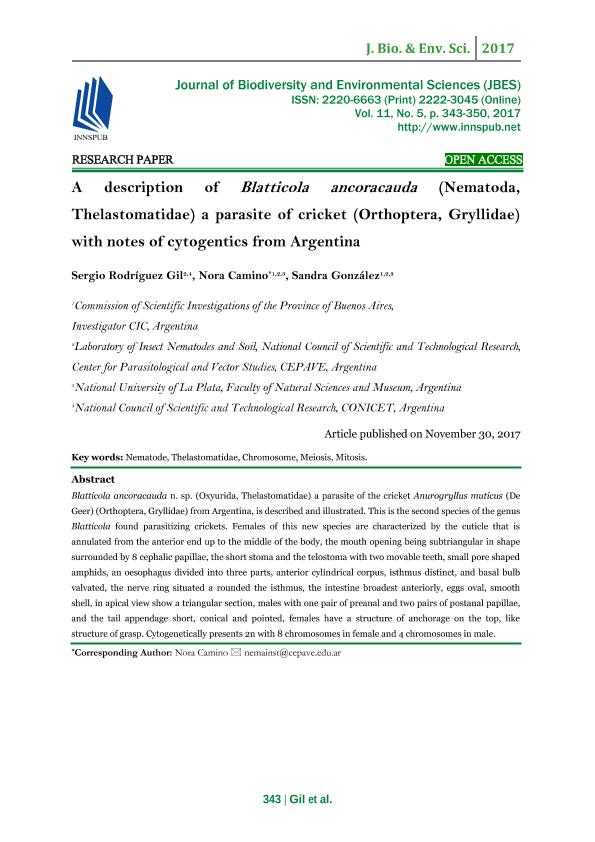Artículo
A description of Blatticola ancoracauda (Nematoda,Thelastomatidae) a parasite of cricket (Orthoptera, Gryllidae) with notes of cytogentics from Argentina
Fecha de publicación:
12/2017
Editorial:
International Network for Natural Sciences
Revista:
Journal of Biodiversity and Environmental Sciences
ISSN:
2222-3045
Idioma:
Inglés
Tipo de recurso:
Artículo publicado
Clasificación temática:
Resumen
Blatticola ancoracauda n. sp. (Oxyurida, Thelastomatidae) a parasite of the cricket Anurogryllus muticus (DeGeer) (Orthoptera, Gryllidae) from Argentina, is described and illustrated. This is the second species of the genusBlatticola found parasitizing crickets. Females of this new species are characterized by the cuticle that isannulated from the anterior end up to the middle of the body, the mouth opening being subtriangular in shapesurrounded by 8 cephalic papillae, the short stoma and the telostoma with two movable teeth, small pore shapedamphids, an oesophagus divided into three parts, anterior cylindrical corpus, isthmus distinct, and basal bulbvalvated, the nerve ring situated a rounded the isthmus, the intestine broadest anteriorly, eggs oval, smoothshell, in apical view show a triangular section, males with one pair of preanal and two pairs of postanal papillae,and the tail appendage short, conical and pointed, females have a structure of anchorage on the top, likestructure of grasp. Cytogenetically presents 2n with 8 chromosomes in female and 4 chromosomes in male
Palabras clave:
Nematode
,
Thelastomatidae
,
Chromosome
,
Meiosis
,
Mitosis
Archivos asociados
Licencia
Identificadores
Colecciones
Articulos(CEPAVE)
Articulos de CENTRO DE EST.PARASITOL.Y DE VECTORES (I)
Articulos de CENTRO DE EST.PARASITOL.Y DE VECTORES (I)
Citación
Rodríguez Gil, Sergio Gustavo; Camino, Nora Beatriz; González, Sandra Elizabeth; A description of Blatticola ancoracauda (Nematoda,Thelastomatidae) a parasite of cricket (Orthoptera, Gryllidae) with notes of cytogentics from Argentina; International Network for Natural Sciences; Journal of Biodiversity and Environmental Sciences; 11; 5; 12-2017; 343-350
Compartir




